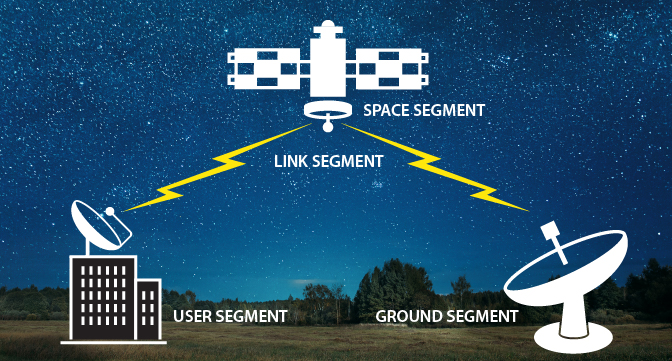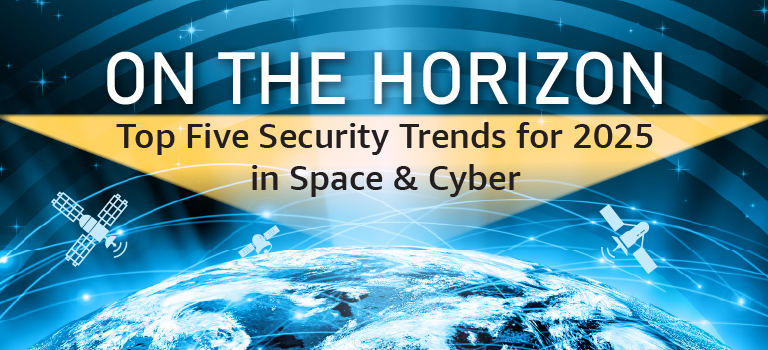Every day in the news there are novel space discoveries and increasingly successful launches of space assets. On January 16, 2025, Blue Origin’s New Glenn rocket was successfully launched from Florida’s Cape Canaveral Space Force Station. In just 12.5 minutes, the New Glenn upper stage rocket reached orbit. This launch was significant because now Jeff Bezo’s company Blue Origin can join the ranks of Elon Musk’s SpaceX. With all the commercial interest in space, one can imagine that countries and adversaries alike are taking a look, and when that happens, one needs to be prepared for threats and vulnerabilities.
Space infrastructure has become increasingly vulnerable to cyber threats, and disruptions in one domain can have cascading effects. Where do these threats appear? Essentially throughout every stage of life. Space systems must be secured in all segments:
User, Ground, link, and Orbit

The intersection of space and cyber have become inseparably connected driven by rapid technological advancements along with increasing space launches and traffic. All of these contribute to the rising complexity of cyberthreats targeting space assets. While stakeholders are adapting to this reality, today great efforts must be taken to fortify space assets and strengthen cyber defenses. Otherwise, we are all at risk. So, with all of this activity, what do we see will be on the horizon? Below are the top five space and cyber trends expected to shape the landscape by 2025:
Here are our predictions for 2025’s Top 5 Security Trends for Space and Cyber:
#1 Cyber Survivability for Space Assets
As reliance on space infrastructure continues to grow—spanning satellites for communication, navigation, and defense systems—cyber survivability becomes essential. The growing intersection between space and cyberthreats means that a breach in one domain can compromise the other. Space organizations will focus on strengthening the cyber posture of space assets across all segments: user, ground, link, and orbit. This will include integrating automated threat detection, AI-driven analysis, and real-time response mechanisms to guard against increasingly sophisticated cyberattacks. These measures will ensure that space-based technologies remain secure, operational, and resilient to both cyber and kinetic threats that could disrupt space missions.
#2 End-to-End Threat Awareness and Cyber Defense for Space Assets
As space systems and cyber technologies become increasingly intertwined, threat awareness must evolve to account for the new risks emerging at the intersection of these domains. All stakeholders will need to enhance their ability to monitor not only physical activities in space but also cyberthreats targeting space infrastructure across all segments. Integrating advanced sensor networks, AI-powered data analytics, and global partnerships will be crucial to identifying cyberattacks on space systems in real-time, whether they affect space-based hardware, ground control stations, or communication links. This convergence of end-to-end threat awareness (EETA) with cyber measures will provide a more holistic defense strategy.
#3 AI/ML-Powered Cyber Defense for Space
As cyberthreats to space assets become more sophisticated, Artificial Intelligence and Machine Learning (ML) will play a transformative role in defending space systems. AI/ML technologies will increasingly be deployed to predict and detect cyberattacks targeting space infrastructure, autonomously responding to emerging threats in real-time. These AI-powered defenses will be critical in detecting anomalies in the different space segments preventing malicious activity before it can disrupt critical operations.
#4 Collaborative Cyber Defense
One can’t go it alone in space. Given the interdependency between space and cyber, vulnerabilities in one segment can compromise the entire system, making it critical to address these risks collectively. The intersection of cyberthreats and space assets is a global issue that requires cooperation across governments, private sector entities, academia and international partners. Collaborative defense initiatives will become even more crucial, with joint cyber standards for space, information-sharing protocols, and coordinated defense strategies being developed across borders and industries. Through these cooperative efforts, space and cyber stakeholders can strengthen and increase defenses against cyberthreats targeting space assets. A more resilient global space infrastructure is needed for earth’s communication and human’s daily lives.
#5 Resilient Space Systems
As space systems are increasingly vulnerable to cyberattacks, physical damage, and space debris, the need for resilient, redundant space infrastructure will become more pronounced. The focus on resilience will expand to include cyber-robustness, ensuring that space assets remain operational even if part of the system is compromised by a cyberattack or other disruptive events. Redundant satellite networks, modularized space systems, and layered defense strategies will help safeguard critical space operations, ensuring continuity across all space segments.
Conclusion
The intersection of space and cyber is essential to safeguarding the working of all critical infrastructure. The increasing convergence of space systems with cyber technologies means that threats in one domain can no longer be addressed in isolation. Protecting all segments of space infrastructure: user, ground, link, and orbit will be vital to maintaining the confidentiality, integrity and availability of space-based systems.
By leveraging advanced technologies like AI/ML, enhancing global collaboration, and building more resilient systems, all space stakeholders will be better equipped to protect space assets from evolving cyberthreats in an increasingly complex and interconnected environment. ![]()
For resources on this topic, please look to author Dr. Janosek’s prior academic publications on space and cybersecurity available at: Publications – Diane M. Janosek – JANOS LLC
Reference for Blue Origin launch: Jeff Bezos’ Blue Origin launches massive New Glenn rocket into orbit on 1st flight (video) | Space
Note: The views expressed are those of the authors and do not reflect the official guidance or position of the United States Government, the Department of Defense, the United States Air Force or the United States Space Force.
Diane M. Janosek, PhD, JD, CISSP



Leave a Comment